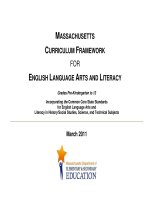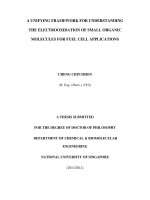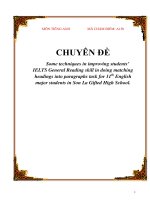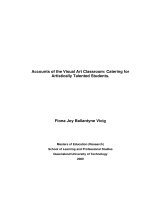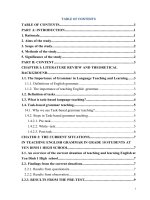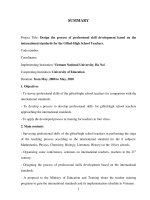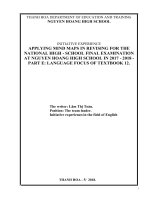Visual Art Curriculum Framework For Small Group High School Instr
Bạn đang xem bản rút gọn của tài liệu. Xem và tải ngay bản đầy đủ của tài liệu tại đây (1.28 MB, 96 trang )
Georgia State University
ScholarWorks @ Georgia State University
Art and Design Theses
Ernest G. Welch School of Art and Design
8-8-2017
Visual Art Curriculum Framework For Small Group High School
Instruction: An Art Teacher's Reflections
Penny Lee Colangelo MS
Follow this and additional works at: />
Recommended Citation
Colangelo, Penny Lee MS, "Visual Art Curriculum Framework For Small Group High School Instruction: An
Art Teacher's Reflections." Thesis, Georgia State University, 2017.
/>
This Thesis is brought to you for free and open access by the Ernest G. Welch School of Art and Design at
ScholarWorks @ Georgia State University. It has been accepted for inclusion in Art and Design Theses by an
authorized administrator of ScholarWorks @ Georgia State University. For more information, please contact
VISUAL ART CURRICULUM FRAMEWORK FOR SMALL GROUP HIGH
SCHOOL INSTRUCTION: AN ART TEACHER’S REFLECTIONS
by
PENNY LEE COLANGELO
Under the Direction of Melody Milbrandt
ABSTRACT
For this thesis, I developed a curriculum for high school art students using centers for
small group instruction that helped them develop skills and knowledge in creating art. The type
of small group instruction that I implemented is centered based and includes a teacher facilitated
component, an interactive activity, and a project done in a small group at their desks. The
groups were broken down in levels of ability, skill, and the extra time needed for students to
complete their work. By developing this type of curriculum for the Visual Art 1 course, the goal
of small group instruction in the art classroom is to support student understanding of the artistic
process through successful experiences.
INDEX WORDS: Centered small group instruction, Curriculum, Reflections, Teacher
facilitated, Interactive, At-your-seat -work
VISUAL ART CURRICULUM FRAMEWORK FOR SMALL GROUP HIGH
SCHOOL INSTRUCTION: AN ART TEACHER’S REFLECTIONS
by
PENNY LEE COLANGELO
A Thesis Submitted in Partial Fulfillment of the Requirements for the Degree of
Master of Art Education
in the College of Arts and Sciences
Georgia State University
2017
Copyright by
Penny Lee Colangelo
2017
DEVELOPING A VISUAL ART CIRRICULUM FRAMWORK FOR SMALL GROUP HIGH
SCHOOL INSTRUCTION
by
Penny Lee Colangelo
Committee Chair:
Melody Milbrandt
Committee:
Melanie Davenport
Kevin Hsieh
Electronic Version Approved:
Office of Graduate Studies
College of Arts and Sciences
Georgia State University
August 2017
iv
DEDICATION
In memory of Carol Ann Burnsworth who cultivated the love of art and education in all
of my endeavors.
v
ACKNOWLEDGEMENTS
I want to acknowledge the support and encouragement of my professors Melody
Milbrandt, Melanie Davenport, and Kevin Hsieh.
v
vi
TABLE OF CONTENTS
ACKNOWLEDGEMENTS ............................................................................................ V
1
2
3
INTRODUCTION ...................................................................................................... 1
1.1
Purpose of the Study ........................................................................................... 1
1.2
Expected Results .................................................................................................. 2
REVIEW OF LITERATURE.................................................................................... 4
2.1
Centered Small Group Instruction and Curriculum Strategies ..................... 4
2.2
Student Development and Behavior .................................................................. 9
METHODOLOGY ................................................................................................... 13
3.1
Question for discovery: ..................................................................................... 13
3.2
High School Setting ........................................................................................... 14
3.2.1 Participants.................................................................................................... 15
3.3
The Procedure ................................................................................................... 16
3.3.1 Defining Centered Small Groups……………………………………………16
3.3.2 The Framework of the Curriculum ………………………………………….18
3.3.3 Time Line and Lesson Outline ………………………………………………19
3.3.4 Assessment and Student Progress ……………………………………………20
4
IMPLEMENTATIONS: REFECTIONS AND DISCUSSIONS .......................... 23
4.1
Reflections and Discussions .............................................................................. 26
4.2 My Reflections ………………………………………………………………... 28
4.2.1 Week One: Lesson One; Organic vs. Geometric ………………………28
vii
4.2.2 Week Two: Lesson Two; What Do You Value?.......................................31
4.2.3 Week Three: Lesson Three; Value Circle Close-Up…………………....34
5
CONCLUSIONS …………………………………………………………………...39
REFERENCES ................................................................................................................ 44
APPENDICES ................................................................................................................ 47
Appendix A .................................................................................................................. 47
Appendix A.1 ............................................................................................................. 49
Appendix A.2 ............................................................................................................. 51
Appendix B .................................................................................................................. 54
Appendix B.1 ............................................................................................................. 57
Appendix B.2 ............................................................................................................. 60
Appendix C .................................................................................................................. 63
Appendix C.1 ............................................................................................................. 69
Appendix C.2 ............................................................................................................. 76
viii
ix
1
1
INTRODUCTION
As a new teacher, I am interested in always improving my curriculum and projects for my
art classes. During a professional development class, I was encouraged to try this type of small
group instruction. In the county where I teach, small group instruction was not accepted by
many high school teachers, including any art teachers. I was intrigued by a Professional
Development presenter, who was interested in learning how small group instruction worked in an
art classroom. This type of instruction is a nontraditional way of teaching art. The typical art
lesson is a taught with information presented to the group and then helping students individually.
Although small group instruction has been traditionally used in the beginning grades of
elementary schools and special needs groups in both Gifted and Special Education classrooms, it
is now being used with academic classes in the upper grade levels. It is used to make sure all
students obtain and retain the information given and help keep students engaged during
instruction. The students who move quickly in each of the activities can go forward to the next
very easily. The student who needs more time and extra help can get help without being
overwhelmed with the next activity until they are ready.
Art is typically not a subject that uses organized small group instruction; it is usually
taught with one on one explanation and teacher demonstration to the whole class. Small group
instruction allows for students to move forward at their own pace and allows the teacher to guide
their practice more specifically which encourages personal growth and individual differentiation.
1.1
Purpose of the Study
The reason I chose developing curriculum for the centered small group instruction for the
visual art course is because of the type of student community in which I teach. The high school
that I work at is a themed Magnet School where gifted students, general education students, and
2
students with special needs are all enrolled in my classes. Also, 9th through 12th graders are all
enrolled in the same art classes. This high school is a Title I school with 64.3% of the students on
free and reduced lunch programs. Our graduation rate is below 75% and we have a high rate of
students who discuss dropping out as early as the second semester in 9th grade. The goal for this
research was that small group instruction may help ALL students pass the class and feel
successful in creating art.
In my research, the focus was on centered small group instruction using three groups: the
Teacher-Facilitated, the Interactive, and At-your-Seat -Work. The goals were for students to
work at their own pace, get one on one instruction from the teacher while continuing to work on
their art projects, and have opportunities to discuss their artwork with their peers. By using this
type of instruction, students stay focused and productive in the art classroom.
1.2
Expected Framework for Instruction
The course time for art class is a ninety-minute block, which allows approximately 20
minutes in each of the three groups. The remaining thirty minutes is structured for a 20-minute
lesson in the beginning and 10 minutes for cleaning up at the end of class. The lesson begins
with whole class instruction and communication. Then the first group works in the TeacherFacilitated-Group where a “mini” lesson supports the main instruction. Here the teacher
instructs, demonstrates, and works with approximately 10 students at a time. In this group, the
teacher can see if students are struggling with the concept and need to stay for a second
presentation and support. The student can stay in this group until they feel confident and have
mastered the task and information. Students who achieve the objectives quickly can move into
the other groups faster to complete the other tasks and therefore work at their own pace. While
these students are working with the teacher, the Interactive Group is working on a small activity
3
that supports a previous lesson or skill development. For example, in Visual Art 1, one of the
objectives is that the student will draw the object provided and show how to render value with a
designated light source. This activity is due at the end of class as a ticket out. Sometimes it can
be a lesson in two parts, due on the second day. The last group is the At-Your-Seat-Work, which
usually involves student projects. These projects are given a set time to complete and the student
continues to work on this in the 20 minutes of the rotation of the block period. I felt that using
this instructional delivery system would give the student more opportunities to achieve success
and become confident in producing art.
4
2
2.1
REVIEW OF LITERATURE
Centered Small Group Instruction and Curriculum Strategies
Centered small group instruction is a nontraditional method of teaching students that is
beginning to be used in higher educational classes. Research done by Achen, Dodd, and
Lumpkin (2015), in Student Perceptions of Active Learning, shows the increasing success of
using student centered environments and activities to impact student learning. According to
Doyle (2008), learning centered environments are the most important way to teach in optimizing
student learning. He suggests that learner centered environments help students take ownership of
their own learning process by making choices of how they will learn and become more
responsible for the outcome. Centered small group instruction can allow students to be positive
and interact with the lessons and the teacher more readily and personally. The teacher can help
students understand the concepts and develop skills like drawing, rendering value, and creating a
good composition by using interactive activities and one on one instruction in the TeacherFacilitated Group. Relationships with peers and the teacher can encourage students to believe
that they can accomplish their learning goals.
According to a research study by Borůvkova and Emanovský (2016), small group
instruction helps students build relationships which in turn creates a better working environment.
This study showed the increase in participation in isolated learners especially in the cooperative
learning. Students developed relationships that helped them with their learning processes, they
interacted and worked together with peers in order to develop skills. Small group instruction
makes sure all students learn the content effectively, especially through the Interactive Group.
Students are forced to accomplish the goal with students that they normally would not be put
together. These students will help each other and develop a social interaction that can enhance
5
small group instruction. This small group learning allows the student to be the focus in the
learning process. This differs in more traditional methods were the teacher is the center of
activity. In small group instruction, the teacher’s role is a facilitator to the students’ process not
a lecturer as in most tradition classrooms. This type of learning allows student to converse and
share skills that lead them to become more expressive, share what they know, what they do not
know, and what they might want to learn. Students will take more risks and experiment knowing
that there is a safety net amongst each other. In this research, they concluded that there are five
criteria for the cooperative project: (1) positive interdependence, (2) individual accountability,
(3) face to face interaction for at least part of the work, (4) appropriate use of interpersonal skills,
and (5) regular self-assessment of team functioning (2016).
The cooperative art project needs to make sure that students have independence amongst
themselves and within their group to insure accountability. These relationships need to be in a
positive environment and the student needs to understand that they have accountability separate
from the group. The project needs hands on by all members of the group and that they react to
each other in an appropriate manner to fulfill a creative experience. The assessment needs to be
an evaluation of the group’s interaction together (2016).
The teacher’s role is to facilitate and requires pre-planning of the groups and the
instruction needed. The teachers will give instruction and guide students to stay on task, provide
feedback, and skill support. Monitoring student and group progress is essential to the success of
the student and the group. Assessing each student’s participation and group interaction will help
support the end result of the project. Teachers will check for individual accountability and group
success (Borůvkova and Emanovský, 2016).
6
Other support for this type of curriculum development comes from the article, “How do
we teach? Results of a National Survey of Instruction in Secondary Art Education,” David
Burton (2001). He discusses the practices of art teachers in a secondary classroom. The survey
shows teachers’ preferred teaching methods and suggests that further studies could help enhance
art-teaching practices. It raises the questions on whether teachers could use more support in
these strategies or and how effective they are for student learning. Burton’s research shares the
way in which most art teachers are teaching secondary art and shows the need to extending
traditional practices. Teachers should experiment and be open to change the art curriculum
according to the current educational climate. The centered small group instruction is not a
traditional form of teaching art that can be used when students are put in the art classroom
without choice just to complete a graduation requirement. Using centered small group
instruction practices students can stay with the teacher for additional help and build confidence
and skill. Demonstrations on specific techniques can be designed to the individual student. In
the Interactive Group students can discuss and collaborate the activities that will support
instruction, enhance skill development, and build confidence in the art process (Burton, 2001).
Karen Popovich (2006) challenges art teachers to develop curriculum through their own
approach that expands from the art classroom to other subjects and explore other methods that
will work with students’ needs. She discusses how the teacher becomes the facilitator and that
the curriculum can address the individual students process. Small group instruction can be a
method in achieving student success. The Teacher-Facilitated Group works with about ten
students at a time and ensures that the student walks away knowing the particular skill required
or the information needed to accomplish the project. This grouping also allows for the teacher to
demonstrate and work with each student in a one on one process. It also provides the teacher
7
opportunities to see which of the students should move at a faster pace and which students need
extra help. This is the perfect way to develop individual differentiation in instruction. Teachers
need to view curriculum development as an ongoing process, which will lead to better student
success.
Charles M Dorn in his book Mind in Art (1998) discusses that knowledge in art is
constructed in creating and processing art Dorn compares and contrasts Piaget and Lowenfield’s
child’s growth and perception in art and how a teacher can create a conceptual curriculum that
will support student learning. Concepts can scaffold and repeat to include all learning abilities.
Centered small group instruction is perfect for all types of learners. The Interactive Group
supports concepts that can scaffold and help with student growth. Students have time to think
and process the knowledge learned in the Teacher-Facilitated and Interactive Groups.
A study of small group curriculum for gifted students was conducted over five years by
Peterson and Lorimer (2012) focused on teacher facilitators. The study concluded that teachers
had more confidence and developed a better relationship with students while teaching in small
groups. Responses from students stated that teachers became more relaxed and at ease about the
instruction. It is important for teachers to develop a relationship with their students. This study
supports the development of curriculum for centered small group in that students are the focus
and how the environment plays an important role in the different groups. It is especially
important in the Teacher-Facilitated Groups where those relationships can be cultivated and
grown to help with each student’s success. In such a group, a one on one nurturing environment
can take place and help students overcome any inhibitions of art and its creative process.
In a study by Mark Graham (2003) of an adolescence drawing class, the goal was to
achieve a higher skill level in a classroom of 21 students raging in different skill levels. He states
8
during a time of discovery for these students that he engaged them in a curriculum of European
Renaissance that usually is hard for students to relate to. These students became successful in
creating their art when they could intermingle interpersonal references in their art. Some of their
success was felt in their ability to move about the room, socialize, and discuss their work
amongst their peers. Although the subject of European Renaissance was reflected in skill
development it was understood by integrating their own culture, which gave students new
insights into their creative process. By socializing and moving about the room students could
collaborate their ideas and process. Centered small group instruction supports this process and
art development. The Interactive Group and the At-Your-Seat-Group allow the students to move
about the room and share information. They can collaborate and discuss ideas and downfalls,
give suggestions to each other in what works best, and not only take part of learning but teach
others what they have learned (Graham 2003).
In the article, Five High -Impact Teaching Practices, by L. Dee Fink (2016), these five
teaching practices can help increase student engagement and student learning. It is based on 40
years of experience in developing and implementing these practices. The five HITP are: 1)
helping students become meta-learners, 2) learning centered course design, 3) using small groups
in a powerful way, 4) service-learning/community engagement---with reflection, and 5) being a
leader with your students. Fink also states that even though you, the teacher, might not use all
five, just using two or three will give a better learning experience to your students. The centered
small group curriculum that was developed uses two of the HITP’s; learning centered course
design and small groups. My curriculum plans for specific activities and instruction for all three
of the centered small groups; Teacher- Facilitated, Interactive, and At-Your-Seat-Work Groups.
9
Patricia Samson (2015) discusses, in her article of, Fostering Student Engagements:
Creative Problem Solving in Small Group Facilitators, using small groups to implement the idea
of creative problem solving as a strategy. The use of active strategies like this one works well in
the small group curriculum planning where creative problem solving and critical thinking is the
basis in creating art. Art projects in themselves are defined by both problem solving and critical
thinking. The art process begins with a problem to solve and encourages different ways in which
to try to reach the goal of completion. Critical thinking is a process of self -directed and selfassessment, where a student improves upon their own process. The lessons were structured as to
have content and skill development be a process that students will have to discover and practice
to achieve the art projects goal.
In the curriculum for centered small group instruction strategies like some of Marzono’s
“high yield” nine, are used to support the lesson and student achievement (Marzano 2009.) Three
of the Marzano’s nine that will be used are reinforcing student effort and provide recognition,
cooperative learning, and setting objectives and provide feedback. Reinforcing effort and
providing recognition is one of the strategies that was used in the curriculum for the Visual Art 1
course. In the Teacher-Facilitated-Group, the teacher can provide immediate feedback,
recognize student achievement, effort, and give more support where needed. Cooperative
learning is well supported in small groups where students interact with each other for support
and idea development. The lesson will set the objectives, and in the Teacher-Facilitated Group
the teacher will give immediate feedback to help students with content and skill development.
2.2
Student Development and Behavior
In developing the high school curriculum, teachers need to understand the behavior of
their students. In Art and the Adolescence, by John A. Michael (1983), discusses how adolescent
10
behavior should be considered in developing the art curriculum. Michael states that behaviors
that are typically ignored like confidence, self-esteem, creativity, and the development of their
aesthetic stance are some of the key factors to understand when developing art curricula. He
discusses that content, art skills, and art attitude should play an important role in the student’s
success. Small group instruction will allow for these three functions to take place. In the
Teacher-Facilitated Group, the content will be delivered and mastered. Here students will work
directly with the teacher to make sure that there is complete understanding. The Interactive
Groups will allow students to work on activities to support the content and build specific skills.
The student can discuss their feelings and attitudes about the art project, the content, or about
their process. The At-Your-Seat- Group allows students to practice creativity and confidence
needed for the art project. By scaffolding the information and understanding the behavior of
high school students as stated by Michael (1983), that small group instruction will help students
succeed, build confidence, and self-esteem when creating art.
The other topic that Michael talks about is the importance of student oriented art projects.
Allowing students to have more choices and self-directed projects gives the control to students
and helps them in their creative process. The centered small group curriculum is about students
having more control over their outcome with the choice of requesting more guidance when
needed. The curriculum allows for more student choice while still being accountable for content.
There are also interactive activities that will support skill development and build confidence for
the student to branch out and experiment.
Most high school students, when asked will describe the feeling of being creative with
being successful when making art. In supporting a student’s creativity according to Kerry
Freedman (2010), an updated and different approach is needed. Freedman redefines creativity
11
by not only taking in consideration the process and outcome, but by interpreting the physical
motivations and the context in which the art is created. Freedman explains this reasoning in
seven characteristics of creativity. These characteristics include: 1) critical reflection, (2) interest
based, (3) that there is a learning process, (4) functional, (5) is a social activity, (6) dependent on
reproduction, (7) is a form of leadership. In understanding and using these characteristics can
help with the development of the small group curriculum. It is important for the art instructor to
understand and nurture creativity in their students. Students want to feel successful when
creating art. The small group instruction is a way in which helping students develop the
confidence as well as skill in their art process. In the Teacher-Facilitated Group the student can
stay as long as they need to understand the content, perfect a certain skill, or just get emotional
support during the lesson. The Interactive Group is an activity that is independent and used to
scaffold and to gain support for the main project. This becomes a social activity that relies on
reproduction and understanding its function. The At-Your-Seat-Work Group helps students
discover the art process and is usually chosen from the student’s interests. The small group
instruction works well with developing students as artists and nurturing their artistic process.
Centered small group instruction is an effective strategy for supporting students in
developing better relationships with their peers and teacher. Traditional teaching methods are
being challenged to better meet the educational needs of students. A curriculum using centered
small group instruction allows the teacher to better determine where students need more help,
and also allows students to be more independent, work at their own pace, and make their own
choices. Students are more engaged in learning and develop more confidence if they have
multiple opportunities to make their own choices and be responsible for their own success.
12
Teachers can better adjust their methods to address student needs while making sure all students
learn the specific contenet.
